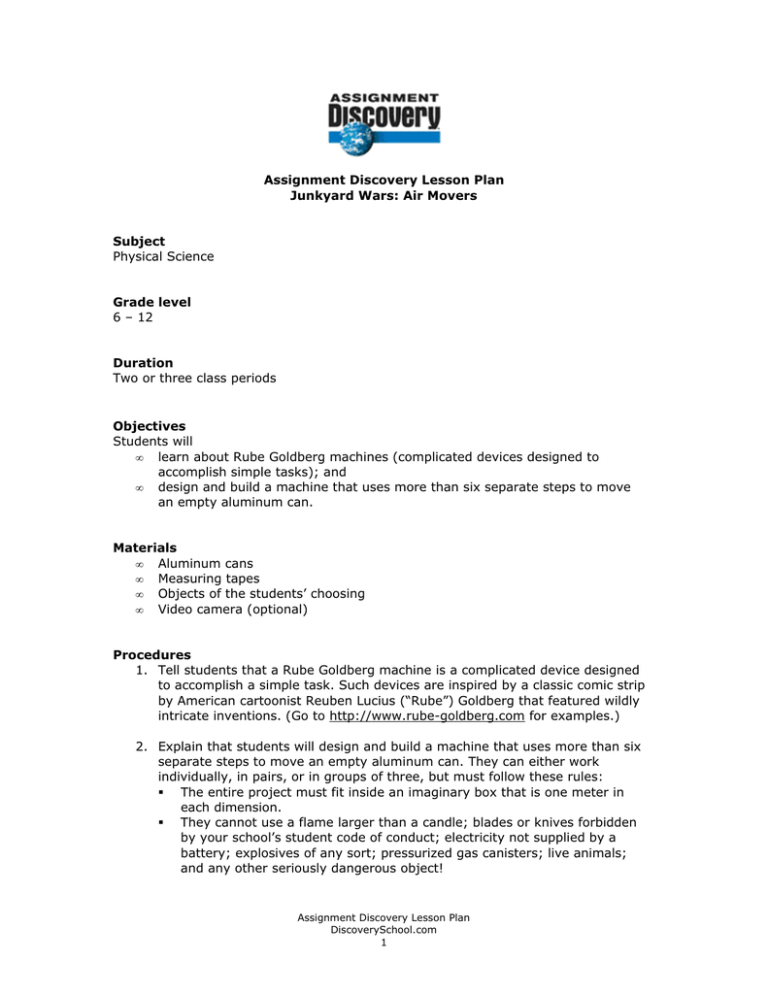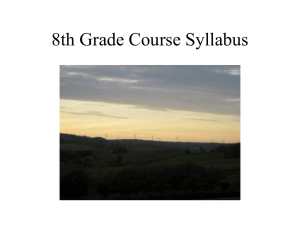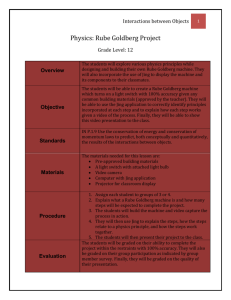Assignment Discovery Lesson Plan Junkyard Wars: Air Movers
advertisement

Assignment Discovery Lesson Plan Junkyard Wars: Air Movers Subject Physical Science Grade level 6 – 12 Duration Two or three class periods Objectives Students will • learn about Rube Goldberg machines (complicated devices designed to accomplish simple tasks); and • design and build a machine that uses more than six separate steps to move an empty aluminum can. Materials • Aluminum cans • Measuring tapes • Objects of the students’ choosing • Video camera (optional) Procedures 1. Tell students that a Rube Goldberg machine is a complicated device designed to accomplish a simple task. Such devices are inspired by a classic comic strip by American cartoonist Reuben Lucius (“Rube”) Goldberg that featured wildly intricate inventions. (Go to http://www.rube-goldberg.com for examples.) 2. Explain that students will design and build a machine that uses more than six separate steps to move an empty aluminum can. They can either work individually, in pairs, or in groups of three, but must follow these rules: The entire project must fit inside an imaginary box that is one meter in each dimension. They cannot use a flame larger than a candle; blades or knives forbidden by your school’s student code of conduct; electricity not supplied by a battery; explosives of any sort; pressurized gas canisters; live animals; and any other seriously dangerous object! Assignment Discovery Lesson Plan DiscoverySchool.com 1 3. Students may start the device in any way, but the starting step should not require large force or careful aiming. Tell students: Make sure your project is reliable! Murphy’s Law (“Anything that can possibly go wrong will go wrong.”) is extremely powerful. 4. To count as a separate step, the action must involve a change in the type of energy used. For example, three successive objects rolling down a ramp are not acceptable because all three are changes in gravitational potential energy. 5. The final step must move the aluminum can at least 0.5 meter vertically, horizontally, or some combination of the two. The can may move outside of the imaginary box, but it should do so in a safe manner. Do not use highspeed projectiles! 6. One week before the due date, students will turn in a written description of the machine’s steps from start to finish, including sketches of the parts. Tell the class that the drafts will be looked at individually to make sure the intent of the rules is followed. 7. On the due date, students will turn in a final written description of their machine and its steps. That morning, they will also bring their Rube Goldberg devices to the designated area (for example, the student cafeteria or another area large enough to accommodate them). 8. When class starts, they will have 10 minutes to make final adjustments. Then let the testing begin! Each machine should work unaided: A student should not have to touch it to start the first step or at any time until the aluminum can completes its motion. If possible, videotape the devices in action for posterity. Evaluation The following three-point rubric can be used to evaluate the performance of students during this activity. Three points: Students wrote complete descriptions of their machine and its steps; designed a creative machine and decorated it; built a machine that followed all rules and successfully moved an aluminum can using six or more steps that involved a change in the type of energy used. Two points: Students wrote somewhat complete descriptions of their machine and its steps; designed a somewhat creative machine; built a machine that followed most rules and used four or five steps to move an aluminum can, or six steps that did not all involve a change in the type of energy used. One point: Students wrote incomplete descriptions of their machine and its steps; ignored the rules; built a machine that used three or fewer steps to move an aluminum can, or steps that did not all involve a change in the type of energy used. Vocabulary action Definition: The manner in which a mechanism or instrument operates Assignment Discovery Lesson Plan DiscoverySchool.com 2 Context: To count as a step in this challenge, an action must involve a change in the type of energy used. device Definition: A machine or piece of equipment designed to perform a special function Context: In his famous comic strip, Rube Goldberg created a device he called a “simplified pencil sharpener,” which used a kite, shoe, flannel shirt, moths, opossum, cage, electric iron, tree, and woodpecker. Rube Goldberg machine Definition: A complicated device designed to accomplish a simple task; inspired by a classic comic strip by American cartoonist Reuben Lucius (“Rube”) Goldberg Context: In past years, the annual contest has challenged students to build Rube Goldberg machines that shut off an alarm clock and put toothpaste on a toothbrush. Academic Standards The National Science Education Standards provide guidelines for teaching science as well as a coherent vision of what it means to be scientifically literate for students in grades K–12. To view the standards, visit http://books.nap.edu. This lesson plan addresses the following science standards for grades 5–8: Science as Inquiry: Abilities necessary to do scientific inquiry, Understanding about scientific inquiry Physical Science: Motions and forces, Transfer of energy Science and Technology: Abilities of technological design, Understandings about science and technology This lesson plan addresses the following science standards for grades 9–12: Science as Inquiry: Abilities necessary to do scientific inquiry, Understanding about scientific inquiry Physical Science: Motions and forces, Interactions of energy and matter Science and Technology: Abilities of technological design, Understandings about science and technology Credit Ann L. Hammersly, physics teacher, Chaparral High School, Scottsdale, Arizona Assignment Discovery Lesson Plan DiscoverySchool.com 3


